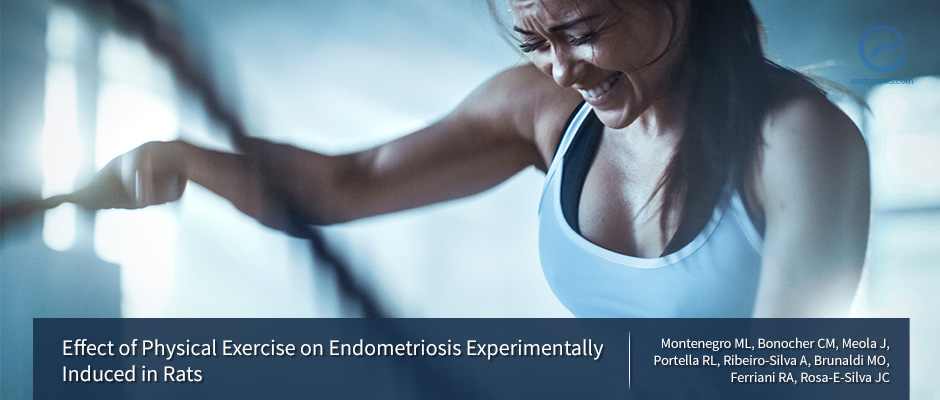Is Physical Exercise Effective in Endometriosis?
Nov 28, 2018
Physical exercise could be recommended to treat endometriosis reducing the size of endometriotic lesions.
Key Points
Highlights:
- This prospective study evaluates the effectiveness of physical activity in endometriosis-induced rats for the treatment of peritoneal endometriotic lesions. The authors also analyzed whether there is a protective ability before induction of endometriosis in these rats.
- They concluded that the treatment and prevention of endometriosis are possible due to the reduction in the inflammatory processes.
Importance:
- Endometriosis is characterized by symptoms including dysmenorrhea, dyspareunia, chronic pelvic pain, and infertility, all of which are associated with a local inflammatory peritoneal reaction. Thus, authors suggest that the prevention and treatment of endometriosis may be achieved with the physical exercise by decreasing the inflammatory reaction and by reducing the size of endometriotic lesions.
What’s done here?
- 70 female Wistar rats were included, dividing into 7 groups: sedentary (no exercise), light exercise (once a week), moderate exercise (3 times a week), and intense exercise (5 times a week).
- 3 groups were introduced to physical exercise before endometriosis induction to understand a possible protective ability and the remaining groups started with physical exercise after endometriosis induction to understand the therapeutic usefulness. One group did not perform the physical exercise, being the control group to compare the results.
- Swimming was chosen as the physical activity because the rats have innate swimming ability thus should be a less stressful activity for these animals.
- Investigators also observed the rats throughout the swimming protocol and if necessary they stimulated them to continue swimming.
- Endometriosis was induced under general anesthesia performing a pelvic incision, resecting and removing the right uterine horn and suturing to its own peritoneum. No hormonal therapy was supplemented before or after the surgery.
- At the end of the 10-week protocol, the rats were reoperated, the endometriotic lesions resected for histopathological and gene expression analysis. Blood samples were collected to evaluate the oxidative stress. A statistical analysis performed for the comparison of different groups.
Key results:
- Swimming as a physical activity after endometriosis induction, is effective in the treatment of endometriosis for reducing the size of lesions, regardless of frequency.
- On the other hand, it was not proven that physical exercise before endometriosis induction had a preventive effect on endometriosis.
- In the group of rats with physical activity after endometriosis induction, Fas gene expression (associated with cellular apoptosis) increased, Mmp gene expression (associated with cell migration and differentiation) along with markers of the proliferation was decreased.
- From the blood samples, the reduction of oxidative stress was observed in all exercise groups.
Strengths and Limitations
- Although inflammation is considered in the pathogenesis of endometriosis, the benefit of physical activity has not been investigated until today. This study is the first to evaluate the relationship between physical activity and endometriosis. The authors evaluated this relationship in rats because being a limitation.
Lay Summary
Endometriosis is defined as the localization of endometrial tissue outside the uterine cavity. Dysmenorrhea, dyspareunia, chronic pelvic pain, and infertility are mostly encountered symptoms of endometriosis. Although there are several theories explaining the pathogenesis of endometriosis, the exact pathogenesis still has not been understood.
Based on the hypothesis of inflammatory predisposition, the physical activity is thought to have a beneficial effect on endometriosis.
Montenegro et al, a group of scientists from Brazil, published an animal study titled as “Effect of Physical Exercise on Endometriosis Experimentally Induced in Rats” in the journal named as Reproductive Sciences. The authors aimed to evaluate the usefulness of physical activity on the treatment and prevention of endometriosis.
They compared 7 groups of 10 rats each: sedentary (no exercise), light exercise (once a week), moderate exercise (3 times a week), and intense exercise (5 times a week). Three groups were introduced to physical exercise before endometriosis induction to understand a possible protective ability and the the rest of the groups started physical exercise after endometriosis induction to understand therapeutic usefulness. They chose swimming as the physical activity, because the rats have innate swimming ability which is a less stressful activity for these animals.
At the end of 10-week swimming, they observed increased levels of Fas gene expression and decreased levels of Mmp gene expression before and after endometriosis induction. It means that proliferation, migration and differentiation of endometriotic tissue decreased. Besides this, oxidative stress was also decreased with physical activity. However, immunohistochemical analyses did not provide useful results with no significant data for protein levels.
“Physical exercise can play an important role in the treatment and prevention of endometriosis and additional controlled studies are necessary in order to clarify the real role of physical exercise in women with endometriosis.” they added.
Research Source: https://www.ncbi.nlm.nih.gov/pubmed/30231769
endometriosis physical activity treatment prevention oxidative stress

